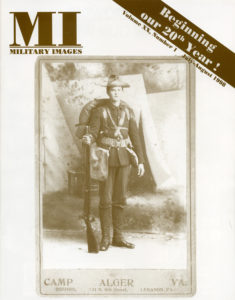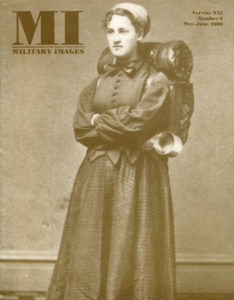The complete issue
Vol. XX, No. 1
(40 pages)
Print edition: Visit our store to check availability
Digital edition: Visit JSTOR.org to purchase
Subscribe to MI
Explore the MI Archives: Browse | Advanced search | Tutorial
Inside
Cover image
A cabinet card from the Anthony Gero Collection is a picture of a young Spanish-American War volunteer.
Table of Contents (p. 1)
Editor’s Desk (p. 3)
The editor announces the commemoration of the centennial of the Spanish-American War and thanks supporters as we begin our 20th year of publication.
Mail Call (p. 5)
Letters include comments on Georgia photographers, Captain Bob, the 6th North Carolina belt buckle and Mobile, Ala., volunteers.
Passing in Review (p. 6)
Five publications are mentioned, including The Wilderness Campaign (University of North Carolina Press) by Gary W. Gallagher, Army of Amateurs: General Benjamin F. Butler and the Army of the James (Stackpole Books) by Edward G. Longacre, The United States Marine Corps in the Civil War—The Second Year (White Mane) by David M. Sullivan, We Came to Fight: The History of the 5th New York Veteran Volunteer Infantry, Duryee’s Zouaves (Schroeder Publications) by Patrick A. Schroeder and Riding with Rosser (Burd Street Press) edited by S. Roger Keller.
On to Cuba!…and Puerto Rico, Hawaii, Guam, the Philippines: Images of the Spanish-American War from the collections of our readers (pp. 7-18)
A survey of 40 images includes a variety of outdoor and indoor views of soldiers. Included are two photographs of Theodore Roosevelt, an image of Joseph Wheeler and other officers and enlisted men.
Capt. Bob’s Caveat Emptorium (p. 19)
In this installment, the sly captain tries to sell readers a grouping of foreign troops—but they are really members of the U.S. VIII Corps, circa 1898.
British Rifle Volunteers of the 1860s: Don’t mistake John Bull for Johnny Reb by Philip Katcher (pp. 20-23)
An analysis of the uniform and equipment of British rifle volunteers is illustrated with six related images.
Spanish Troops in the Philippines, 1896-98 by Ron Field (pp. 25-27)
A uniform analysis provides details on all aspects of the clothing of these soldiers. The text is illustrated with seven images.
Adventures in Paradise: The 1st New York Volunteers in Hawaii, 1898 by Anthony Gero and Roger Sturcke (pp. 28-32)
This unit history traces the regiment from the Declaration of war against Spain through its five-month stay in Hawaii. A total of 14 images illustrates the text.
Uniforms & History by Michael J. McAfee (pp. 33-34)
In “71st Regiment, N.G.N.Y., ‘The American Guard,’ 1898,” McAfee examines the quintessential American army uniform and record of this Empire State regiment. The column is illustrated with a glass lantern slide of troops on parade.
The Auction Block (p. 34)
Sutlers’ Row (pp. 35-37)
Stragglers (pp. 38-40)
Solo photos from the collections of our readers is themed “Strong Men Armed.” It includes nine images that span from the Civil War through World War I.
Back cover
A cabinet card from the B. William Henry Collection is a portrait of QM Sgt. John H. Laabz of the 2nd Wisconsin Infantry, dated Sept. 18, 1898.














































